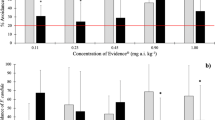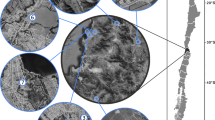Abstract
Purpose
Changes in the behavior of earthworms (for example avoidance of a particular substrate) can influence the soil ecosystem. Our aim was to determine whether the earthworms Eisenia fetida and Lumbricus terrestris are able to avoid ivermectin (a veterinary endectocide belonging to the avermectins). A standard avoidance test with earthworms was conducted using standardized Lufa 2.3 soil (Speyer, Germany) and sandy soil provided by Cinkarna Celje (Slovenia).
Materials and methods
A two-chamber system of avoidance test as described in ISO guideline 17512-1 (ISO 2008) was applied. We investigated the substrate preference of E. fetida and L. terrestris after 48 h at ivermectin concentrations of 8, 32, 64, and 256 mg kg−1 dry soil.
Results and discussion
No deterrent effects were observed for either species and either soil types. E. fetida in Lufa 2.3 soil was clearly attracted to ivermectin. More than 70% of the earthworms preferred soil with ivermectin concentrations of 8, 64, and 256 mg kg−1. No observed effect concentration and lowest observed effect concentration, 2-day exposure, for effects on the avoidance of both species are >256 mg kg−1 dry soil in two different soils.
Conclusions
High percentage of earthworms in the test soil was observed in the experiment with E. fetida in Lufa 2.3 soil treated with 8, 64, and 256 mg ivermectin kg−1. We can conclude that earthworms, as it was observed in E. fetida in Lufa 2.3 soil treated with ivermectin, may be attracted by some chemicals. The percentage of L. terrestris in soil from Cinkarna Celje treated with ivermectin ranged from 39% to 52% and of E. fetida from 33% to 55%.
Similar content being viewed by others
References
Campbell WC, Fisher MH, Stapley EO, Albers-Schonberg G, Jacob TA (1983) Ivermectin: a potent new antiparasitic agent. Science 221:823–828
Floate KD (2007) Endectocide residues affect insect attraction to dung from treated cattle: implications for toxicity tests. Med Vet Entomol 21:312–322
Garcia M, Römbke J, De Brito MT, Scheffczyk A (2008) Effects of three pesticides on the avoidance behaviour of earthworms in laboratory test performed under temperate and tropical conditions. Environ Pollut 153:450–456
Gunn A, Sadd JW (1994) The effect of ivermectin on the survival, behaviour and cocoon production of the earthworm Eisenia fetida. Pedobiologia 38:327–333
Halley BA, Jacob TA, Lu AYH (1989) The environmental impact of the use of ivermectin: environmental effects and fate. Chemosphere 18:1543–1563
Hund-Rinke K, Lindemann M, Simon M (2005) Experiences with novel approaches in earthworm testing alternatives. J Soils Sediments 5:233–239
ISO (1993) ISO guideline 11268-1. Soil quality—effects of pollutants on earthworms (Eisenia fetida)—Part 2: Determination of acute toxicity using artificial soil substrate. International Organization for Standardisation, Geneva
ISO (2008) ISO guideline 17512-1. Soil quality—Avoidance test for determining the quality of soils and effects of chemicals on behavior—Part 1: Tests with earthworms (Eisenia fetida and Eisenia Andrei). International Organization for Standardisation, Geneva
ISO11268-2 (1998) ISO guideline 11268-2. Soil quality—effects of pollutants on earthworms (Eisenia fetida)—Part 2: Determination of effects on reproduction. International Organization for Standardisation, Geneva
Kaneda S, Yamashita N, Uchida T, Shimano S, Miyoshi N, Sasaki M, Enami Y (2005) Effects of ivermectin in dung pats on earthworm (Megascolecidae) populations and pat degradation in Japanese grassland. Appl Soil Ecol 31:280–285
Kolar L, Kožuh Eržen N, Hogerwerf L, Van Gestel CAM (2008) Toxicity of abamectin and doramectin to soil invertebrates. Environ Pollut 151:182–189
McKellar Q, Benchaoui HA (1996) Avermectins and milbemycins. J Vet Pharmacol Ther 19:331–351
Schaefer M (2003) Behavioural endpoints in earthworm ecotoxicology—evaluation of different test systems in soil toxicity assessement. J Soils Sediments 3:79–84
Sousa A, Pereira R, Antunes SC, Cachada A, Pereira E, Duarte AC, Gonçalves F (2008) Validation of assays for the screening assessment of soils under different anthropogenic disturbances. Ecotox Environ Safe 71:661–670
Sun Y, Diao X, Zhang Q, Shen J (2005) Bioaccumulation and elimination of avermectin B1a in the earthworms (Eisenia fetida). Chemosphere 60:699–704
Acknowledgments
This work was supported by the Slovenian Research Agency, Grant J4-9277. Our thanks go to Erik Zidar and Katarina Babnik for technical support. Special thanks to Dr. Jörg Römbke who provided numerous scientific advices during our work.
Author information
Authors and Affiliations
Corresponding author
Additional information
Responsible editor: Kerstin Hund-Rinke
Rights and permissions
About this article
Cite this article
Torkhani, A.L., Eržen, N.K., Kolar, L. et al. Does ivermectin attract earthworms?. J Soils Sediments 11, 124–128 (2011). https://doi.org/10.1007/s11368-010-0284-5
Received:
Accepted:
Published:
Issue Date:
DOI: https://doi.org/10.1007/s11368-010-0284-5




